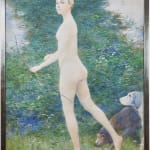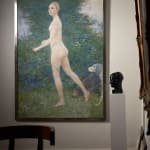Louis-Maurice Boutet de Monvel
Louis-Maurice Boutet de Monvel (1850 - 1913) was a French painter and illustrator. He painted religious themes, genre scenes, figures and portraits. But he is best known for his watercolours for children's books. In this field he was a major figure in nineteenth-century children's book illustration. Boutet de Monvel was born in Orléans, the second of nine children; his father, Benjamin Boutet de Monvel (1820-1880), was a physics and chemistry professor. His maternal grandfather was the tenor Adolphe Nourrit (1802–1839), and there were other artists in the family. During his childhood, he lived mainly in Paris. He started attending the École Nationale Supérieure des Beaux-Arts in the early 1870s. During the Franco-Prussian War, he served in the French army. After the war, he became a student at the Académie Julian, where he worked with Gustave Boulanger and Jules Lefèbvre, who both had a major influence on his early work. He also worked with Carolus-Duran.
In 1873 he exhibited for the first time at the Salon, showing a painting entitled "Temptation". He won a bronze medal in 1878 for "The Good Samaritan" and a silver medal in 1880 for "The Lesson Before the Sabbath." In 1889 he obtained a bronze medal during the Exposition Universelle.
Three trips to Algeria (1876, 1878, 1880) had a strong influence on his style as he responded to the quality of the light. In the Paris Salon of 1880, he showed one of his Algerian paintings,
In 1885, he exhibited the "Triumph of Robert Macaire" at an exhibition organised by the Société des Artistes Français. It caused a controversy and was removed just before the private viewing.
He was an early member of the Salon de la Société des Aquarellistes Français, which had recently been founded by Édouard Detaille. One of the first watercolours he sent to their exhibition was a portrait of a young woman in Renaissance clothing; its great success opened the door for a career as a portrait painter. His skill at capturing the moods of children gained him many commissions from upper middle class parents. He received so many commissions for portraits that at one time he considered giving up book illustration.
In 1876, he married Jeanne Labaigue of Orléans, and their first child was born three years later. Their son Roger would become a writer, and their son Bernard would become a painter. The need to support his family financially pushed him into commercial illustration. In 1881, he illustrated a children’s reading book, this opened the doors to multiple such commissions. He also began to illustrate the children's magazine "Saint Nicolas," continuing until 1890.
In 1895 he published an illustrated children’s book about the history of "Joan of Arc" which has been regarded as his masterpiece. The epic scenes from "Joan of Arc" show the influence of two late-medieval painters: Fra Angelico in the use of modelling and Paolo Uccello in the composition of battle scenes. Drawn with a strong line and clear, harmonious colours, his illustrations drew critical praise even though he himself was disappointed in the quality of the reproductions, which had been done by zincotype, a then-new photo engraving process. As one critic wrote: “Boutet de Monvel's full-page illustrations have a nobility and grandeur akin to the great church frescoes of the Renaissance. Their pleasingly flat rendering combined with a sophisticated use of design elements ... owe a debt to the Japanese prints so popular in the artist's day.”
"Joan of Arc" was a huge success and brought him international recognition. In 1899, he participated in an exhibition organised by members of the Viennese Secession that focused on graphic art. That same year his work was shown in the United States at venues such as the Art Institute of Chicago, the Museum of Fine Arts in Boston, and the Pennsylvania Academy of the Fine Arts in Philadelphia. He went to Chicago for that exhibition but fell ill with a recurrence of a bronchial ailment contracted during the Franco-Prussian war.
At the World's Fair of 1900, he received a gold medal for a panel entitled "Joan at the Court of Chinon" that was part of a commission for a new basilica in Donrémy. It was one of a set of five panels, but the other four were never finished, though a smaller-scale version was completed for senator William A. Clark, who donated it to the Corcoran Gallery of Art in Washington.
Boutel de Monvel died in Nemours in 1913. Not long afterwards, the Manzi & Joyant Gallery organised a retrospective of his work in Paris. Further retrospectives followed, and a large travelling exhibition was organised in the United States in 1987-88.
Boutet de Monvel is still considered a master of the children’s book illustration genre because of the originality of his work. He has been ranked alongside Kate Greenaway and Randolph Caldecott as a leading figure of the 19th century's golden era of children's book illustration.
Museums: in Amiens and Orléans.
Exhibitions
"Jeune Diane" at the Salon of 1893 - Paris



